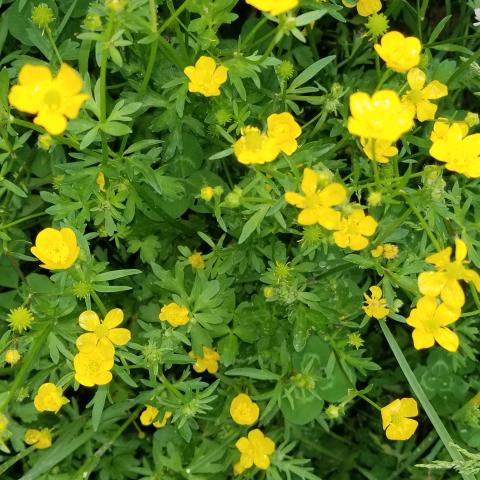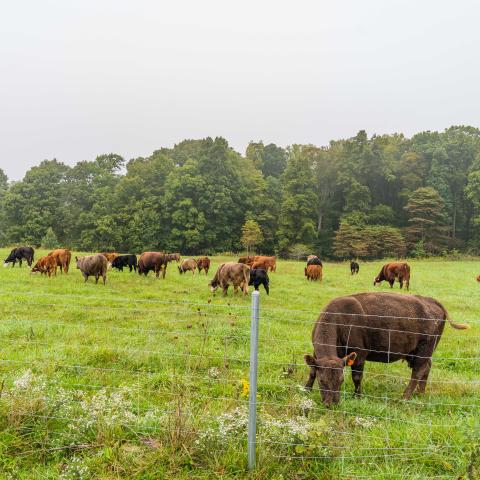NRCS promotes prescribed grazing and improved forage management by providing technical assistance to private landowners.
As a landowner or farm operator, you face many decisions when managing the natural resources on your land. When it comes to improving your pastureland, good management and the right conservation practices makes it possible to have lush, green pastures, clean water, and healthy animals.
Pasture management is managing the forages used by livestock by maintaining cover, providing adequate rest after grazing and using stop-grazing heights to maintain live green leaves during the growing season. Good management also includes following the recommended stock density rate and rotating based on forage availability and livestock nutrition needs.
Following a grazing management plan based on stop-grazing heights can improve soil health such as increasing organic matter, reducing compaction and improving nutrient cycling, which can make your pastures more resilient. Other benefits often include a longer grazing season, greater forage production, less reliance on hay, and a more nutritious food source that improves animal health.
Well-managed pastures not only provide food for your animals, they absorb rainfall, filter runoff and reduce erosion.
Natural Resource Concerns for Pasture Land
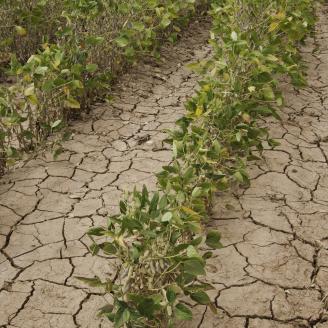
Erosion by wind and water
Soil erosion involves the breakdown, detachment, transport and redistribution of soil particles by forces of water, wind or gravity. Soil erosion on pastureland negatively impacts soil quality, forage productivity, water and air quality, and biological activity.
The economic impact of mitigating soil erosion significantly burdens the agri-business sector and the Nation as a whole. Dust contributions to the atmosphere and delivery of sediment, nutrients, and chemicals to water resources are primary environmental concerns addressed by public policy makers and the stewards of our working lands. Understanding and managing these processes has important long-term implications for pastureland sustainability, natural resource condition and health, and environmental quality.

Water quality from nutrient and pesticide runoff
Water bodies require nutrients, such as nitrogen and phosphorus, to be healthy, but too many nutrients can be harmful. Our nation’s waters, including streams, rivers and wetlands are affected by nutrients on neighboring fields. The effect to a given water body depends on its location and the source of nutrients.
High levels of nitrate in drinking water can cause serious public health concerns. Additionally, increased nitrogen and phosphorus levels in water can produce excessive aquatic vegetation and algal blooms resulting in reduced dissolved oxygen, harmful toxins, and increased water temperature. In extreme cases dissolved oxygen may be so low that dead zones, known as hypoxia, exist where most aquatic life cannot survive. Algal blooms can impart an undesirable taste to potable water that is difficult to remove by water treatment and high ammonia levels are toxic to some freshwater fish species
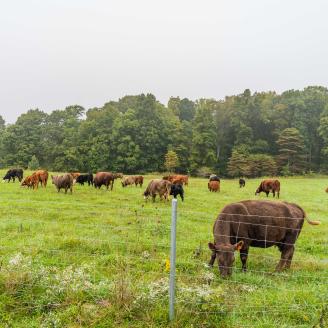
Plant Productivity and Health
Plants established in locations where the climate, soils, or moisture availability are unfavorable can be stressed and may not thrive. Continuous grazing can cause plant stress and decrease plant productivity and health.
Using conservation practices can help establish and maintain plant productivity and health. Assistance from a grazing specialist, forester, or biologist may be needed to set realistic production and conservation goals that consider species suitability, soils, climate, management options, and local data for similar forage systems. Conservation practices in grazing systems can assist in alleviating stressors such as plant vigor and reduced production yields by increasing grazing distribution, managing forage heights, and providing adequate rest periods during seasonal growth variations.

Inadequate Livestock Water
Water is an important but often overlooked nutrient for livestock. Water makes up over 98 percent of all molecules in the body and is necessary for regulation of body temperature, growth, reproduction, lactation, digestion, lubrication of joints, eyesight, and as a cleansing agent. Livestock water requirements are influenced by several factors, including rate of gain, pregnancy, lactation, activity, type of diet, feed intake, distance to acquire, and environmental temperature.
Water quality concerns, for both livestock health and the environment, can be addressed by limiting livestock access to ponds and water bodies or by installing watering facilities. Proper layout of water facilities provides an increased distribution of grazing across the landscape. This ultimately enhances forage production and utilization. The water flow rate to the watering facility must be adequate for the herd requirement. Additionally, the size of the watering facility should be designed to store an adequate amount of water to avoid crowding. Evenly distributed watering facilities in a grazing system help circumvent forage utilization issues within the grazing system.
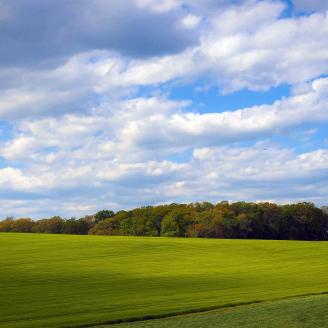
Feed and Forage Imbalance
Livestock require five major classes of nutrients: energy (carbohydrates), protein, minerals, vitamins, and water. All five are essential for normal health and production. Next to water, the greatest livestock requirement is energy, followed by protein, and in smaller amounts minerals and vitamins. Without sufficient energy from feed or forage, utilization of other nutrients is impaired.
Applying the principles of forage growth and production for livestock requires an understanding of how plants interact with soil and climate, as well as understanding the nutritional needs of the animals. Prescribed Grazing is the management of forages by moving animals using a stop grazing height and providing adequate rest for plants. A proper system manages animal number, grazing distribution, and length of grazing periods to provide grazed plants proper recovery time for plant vigor and diversity. Fencing and placement of livestock water can facilitate proper grazing distribution and forage management. Conservation practices, such as pasture and hayland planting and forage harvest management provide guidance to improve the forage base to support the prescribed grazing system.
Common Indiana Pastureland Practices
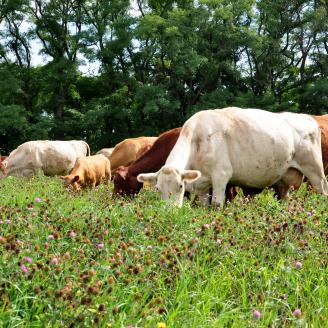
Prescribed Grazing
The management of forages by moving animals using a stop-grazing height and providing adequate rest for plants.
Benefits include:
- Improves or maintains species composition and vigor of plant communities.
- Increases quantity and quality of forage for animal health and productivity.
- Improves infiltration and surface water quality.
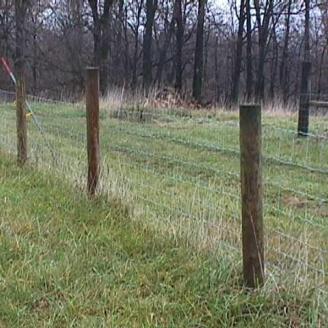
Access Control
Limiting or preventing livestock access to sensitive areas such as streams, ponds, wetlands, and forests. This practice includes fence.
Benefits include:
- Contains and controls livestock movement.
- Protects sensitive areas from grazing livestock,
and eliminates access to unsafe or unstable
areas. - Protects, maintains, and/or improves the quantity and quality of natural resources in an area.
- Protects and maintains vegetation that is often essential to conserving other natural resources.
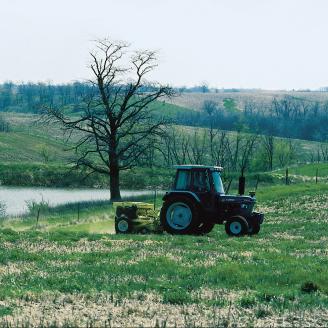
Forage Planting
Establishing adapted and/ or compatible forage species suitable for pasture, hay or biomass production.
Benefits include:
- Improves forage quality and diversity.
- Reduces soil erosion while improving soil health and water quality.
- Improves infiltration and organic matter in the soil as plants recycle.
Heavy Use Area Protection
Stabilizing areas that are frequently used by livestock.
Benefits include:
- Provides a stable, non-eroding surface for areas frequently used by animals, people or vehicles.
- Protects or improves water quality when properly located.
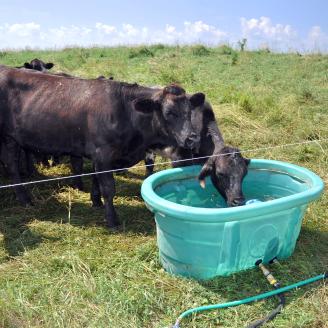
Water Facilities and Pipeline
Permanent or portable water source to provide adequate water for the grazing system.
Benefits include:
- Supplies daily water requirements.
- Improves animal distribution and reduces walking distance.
- Provides an alternative water source to protect a sensitive resource, such as stream or pond.
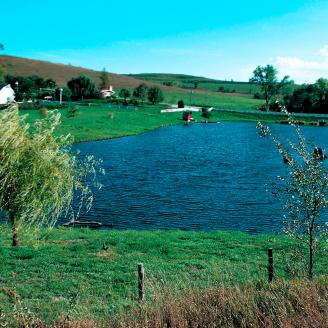
Water Sources
Provides access to water where it is not available such as wells, ponds and spring developments.
Benefits include:
- A clean source of water.
- A source of water for more than one area.
- Good water distribution that improves grazing and animal health.
Stream Crossings
A stabilized area or structure constructed across a stream to provide
a travel way for livestock, equipment, or vehicles.
Benefits include:
- Provides access to another land unit.
- Improves water quality by reducing sediment and nutrient loading of the stream.
- Reduces streambank and streambed erosion.

Fence
A constructed barrier to animals or people.
Benefits include:
- To control movement of animals and people, including vehicles
- Reduce erosion
- Confine compaction
- Improve water quality
- Improve vegetation
- Improve livestock distribution


